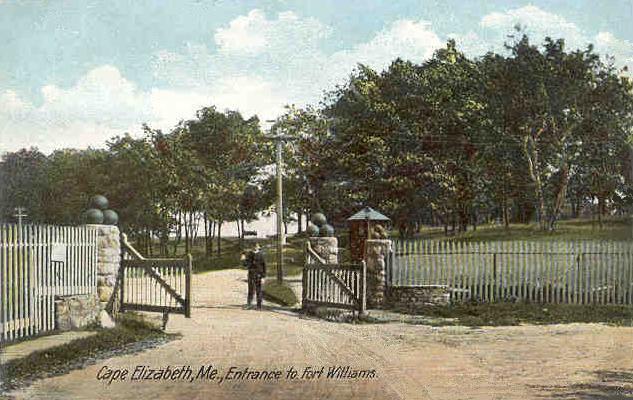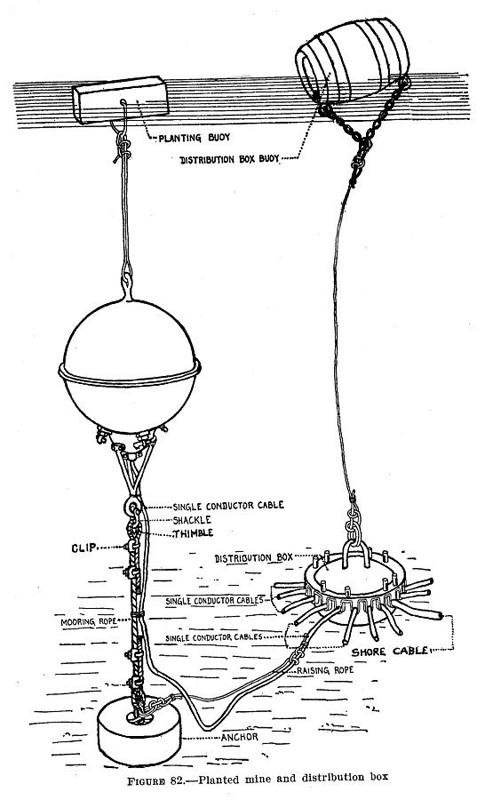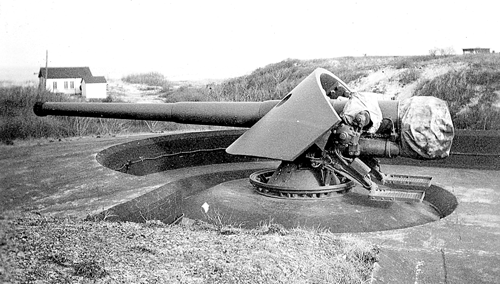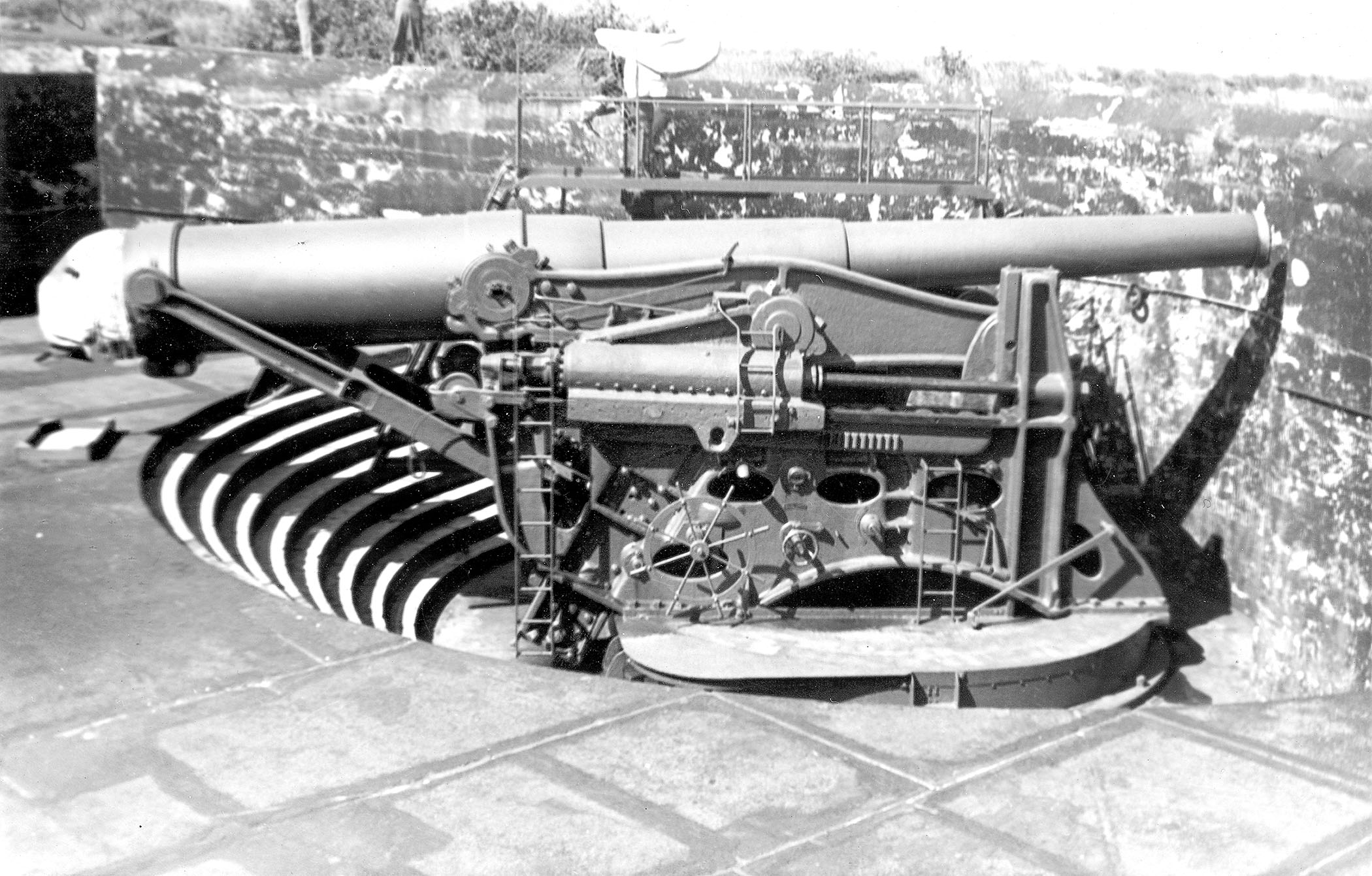|
Fort Williams (Maine)
Fort Williams is a former United States Army fort in Cape Elizabeth, Maine which operated from 1872 to 1964. It was part of the Coast Defenses of Portland, later renamed the Harbor Defenses of Portland, a command which protected Portland's port and naval anchorage 1904–1950. After its closure, it was redeveloped into Fort Williams Park. History Endicott Period A 14-acre purchase near Portland Head Light in 1872 served to establish a sub-post to Fort Preble located at Spring Point. This fortification became known as Fort Williams on April 13, 1899, by order of Army Headquarters (General Order No. 17, Headquarters of the Army, Adjutant General's Office, Washington, D.C.). It was named for Brevet Major General Seth Williams. By 1903, the fort had grown to 90.45 acres. The Board of Fortifications, often called the Endicott Board, recommended a comprehensive program of new fortifications in 1885. Fort Williams was one of the results. It first test-fired its guns in 1898, sho ... [...More Info...] [...Related Items...] OR: [Wikipedia] [Google] [Baidu] |
Harbor Defenses Of Portland
The Harbor Defenses of Portland was a United States Army Coast Artillery Corps harbor defense command. It coordinated the coast defenses of Portland, Maine, the mouth of the Kennebec River, and surrounding areas from 1895 to 1950, beginning with the Endicott program. These included both coast artillery forts and underwater minefields. The command originated circa 1895 as the Portland Artillery District, was renamed Coast Defenses of Portland in 1913, and again renamed Harbor Defenses of Portland in 1925.Rinaldi, pp. 165-166Berhow, p. 430-434Stanton, pp. 455-481 Coast Defenses of the Kennebec The Kennebec coast defense command may have originated as the Kennebec Artillery District with the establishment of Endicott program minefield support facilities in the 1890s at the Civil War-era Fort Popham in Phippsburg, and deployment of mines there during the Spanish–American War. However, it is unclear from references whether the Coast Defenses of the Kennebec (as it was pr ... [...More Info...] [...Related Items...] OR: [Wikipedia] [Google] [Baidu] |
Board Of Fortifications
Several boards have been appointed by US presidents or Congress to evaluate the US defensive fortifications, primarily coastal defenses near strategically important harbors on the US shores, its territories, and its protectorates. Endicott Board In 1885 US President Grover Cleveland appointed a joint Army, Navy and civilian board, headed by Secretary of War William Crowninshield Endicott, known as the Board of Fortifications (now usually referred to simply as the Endicott Board). The findings of the Board in its 1886 report illustrated a grim picture of neglect of America's coast defenses and recommended a massive $127 million construction program for a series of new forts with breech-loading cannons, mortars, floating batteries, and submarine mines for some 29 locations on the US coast. Coast Artillery fortifications built between 1885 and 1905 are often referred to as Endicott Period fortifications. Prior efforts at harbor defense construction had ceased in the 1870s. Si ... [...More Info...] [...Related Items...] OR: [Wikipedia] [Google] [Baidu] |
Submarine Mines In United States Harbor Defense
The modern era of defending American harbors with controlled mines or submarine mines (originally referred to as "torpedoes") began in the post-Civil War period, and was a major part of US harbor defenses from circa 1900 to 1947. Brief history In 1866, the United States Army Corps of Engineers established the Engineer School of Application at Willets Point, New York. The first commander of this school, Major Henry Larcom Abbot, was almost single-handedly responsible for designing and supervising the program of research and development that defined the strategy and tactics for the mine defense of American harbors. Abbot experimented with underwater explosives, fuzes, cabling, and electrical equipment for over a decade before publishing the first manuals on the use of mines in coast defense in 1876–77. At least one experimental controlled minefield was emplaced at this time, at Fort Mifflin in Pennsylvania. However, funding of the fortification program of the 1870s was cancell ... [...More Info...] [...Related Items...] OR: [Wikipedia] [Google] [Baidu] |
Mine Planter
Mine planter and the earlier "torpedo planter" was a term used for mine warfare ships into the early days of World War I. In later terminology, particularly in the United States, a mine planter was a ship specifically designed to install controlled mines or contact mines in coastal fortifications. This type of ship diverged in both function and design from a ship operating as a naval minelayer. Though the vessel may be seagoing it is not designed to lay large numbers of mines in open sea. A mine planter was designed to place Submarine mines in United States harbor defense, controlled minefields in exact locations so that they might be fired individually or as a group from shore when observers noted a target to be at or near a designated mine's position. The terms and types of specialized ship existed from the 1860s where "torpedoes" were made famous in the American Civil War until the demise of large, fixed coastal fortifications brought on by the changes of World War II. History a ... [...More Info...] [...Related Items...] OR: [Wikipedia] [Google] [Baidu] |
Naval Mine
A naval mine is a self-contained explosive device placed in water to damage or destroy surface ships or submarines. Unlike depth charges, mines are deposited and left to wait until they are triggered by the approach of, or contact with, any vessel or a particular vessel type, akin to anti-infantry vs. anti-vehicle mines. Naval mines can be used offensively, to hamper enemy shipping movements or lock vessels into a harbour; or defensively, to protect friendly vessels and create "safe" zones. Mines allow the minelaying force commander to concentrate warships or defensive assets in mine-free areas giving the adversary three choices: undertake an expensive and time-consuming minesweeping effort, accept the casualties of challenging the minefield, or use the unmined waters where the greatest concentration of enemy firepower will be encountered. Although international law requires signatory nations to declare mined areas, precise locations remain secret; and non-complying individ ... [...More Info...] [...Related Items...] OR: [Wikipedia] [Google] [Baidu] |
3-inch M1902 Seacoast Gun
The 3-inch gun M1903 and its predecessors the M1898 and M1902 were rapid fire breech-loading artillery guns with a 360-degree traverse. In some references they are called "15-pounders" due to their projectile weight. They were originally emplaced from 1899 to 1917 and served until shortly after World War II. These 3-inch guns were placed to provide fire to protect underwater mines and nets against minesweepers, and also to protect against motor torpedo boats. In some documentation they are called "mine defense guns". The 3-inch guns were mounted on pedestal mounts (or a retractable "masking parapet" mount for the M1898) that bolted into a concrete emplacement that provided cover and safety for the gun's crew. History The 3-inch mine defense guns were part of a comprehensive plan of new fortifications specified by the Board of Fortifications of 1885. The new forts initially included guns up to 12-inch (305 mm) on disappearing carriages, to conceal the fort from observ ... [...More Info...] [...Related Items...] OR: [Wikipedia] [Google] [Baidu] |
Erasmus D
Desiderius Erasmus Roterodamus (; ; English: Erasmus of Rotterdam or Erasmus;''Erasmus'' was his baptismal name, given after St. Erasmus of Formiae. ''Desiderius'' was an adopted additional name, which he used from 1496. The ''Roterodamus'' was a scholarly name meaning "from Rotterdam", though the Latin genitive would be . 28 October 1466 – 12 July 1536) was a Dutch philosopher and Catholic theologian who is considered one of the greatest scholars of the northern Renaissance.Gleason, John B. "The Birth Dates of John Colet and Erasmus of Rotterdam: Fresh Documentary Evidence", Renaissance Quarterly, The University of Chicago Press on behalf of the Renaissance Society of America, Vol. 32, No. 1 (Spring, 1979), pp. 73–76www.jstor.org/ref> As a Catholic priest, he was an important figure in classical scholarship who wrote in a pure Latin style. Among humanists he was given the sobriquet "Prince of the Humanists", and has been called "the crowning glory of the Christian humanists ... [...More Info...] [...Related Items...] OR: [Wikipedia] [Google] [Baidu] |
6-inch Gun M1900
The 6-inch gun M1897 (152 mm) and its variants the M1900, M1903, M1905, M1908, and M1 (a.k.a. T2) were coastal artillery pieces installed to defend major American seaports between 1897 and 1945. For most of their history they were operated by the United States Army Coast Artillery Corps. They were installed on disappearing carriages or pedestal (a.k.a. barbette) mountings, and during World War II many were remounted on shielded barbette carriages. Most of the weapons not in the Philippines were scrapped within a few years after World War II. History In 1885, William C. Endicott, President Grover Cleveland's Secretary of War, was tasked with creating the Board of Fortifications to review seacoast defenses. The findings of the board illustrated a grim picture of existing defenses in its 1886 report and recommended a massive $127 million construction program of breech-loading cannons, mortars, floating batteries, and submarine mines for some 29 locations on the US coastline. ... [...More Info...] [...Related Items...] OR: [Wikipedia] [Google] [Baidu] |
Julius Peter Garesché
Julius Peter Garesché (April 26, 1821 – December 31, 1862), birth name "Julio Pedro Garesché de Rocher", was an American professional soldier. He was killed at the Battle of Stones River, Tennessee during the American Civil War. The Union Army's Battery Garesché was named for him. Early life Garesché was born near Havana, Cuba. He was sent to Georgetown College, Washington, in 1833, and remained there four years. There he was appointed to the United States Military Academy at West Point. He entered West Point on July 1, 1837 and graduated with the class of 1841, receiving his commission as a second lieutenant in the 4th U.S. Artillery on July 1, 1841. Early career The five subsequent years were spent on the frontier and in garrison duty. His first assignment was to Madison Barracks in Sackett's Harbor, New York from 1841 to 1842. He was briefly reassigned to Fort Monroe in Virginia and then to Fort McHenry in Maryland from 1842 to 1844. He served at Carlisle Barracks in Pe ... [...More Info...] [...Related Items...] OR: [Wikipedia] [Google] [Baidu] |
12-inch Gun M1895
The 12-inch coastal defense gun M1895 (305 mm) and its variants the M1888 and M1900 were large coastal artillery pieces installed to defend major American seaports between 1895 and 1945. For most of their history they were operated by the United States Army Coast Artillery Corps. Most were installed on Disappearing gun, disappearing carriages, with early installations on low-angle barbette mountings. From 1919, 19 long-range two-gun batteries were built using the M1895 on an M1917 long-range barbette carriage. Almost all of the weapons not in the Philippines were scrapped during and after World War II. History In 1885, William Crowninshield Endicott, William C. Endicott, President of the United States, President Grover Cleveland's secretary of war, was tasked with creating the Board of Fortifications to review seacoast defenses. The findings of the board illustrated a grim picture of existing defenses, and in its 1886 report recommended a massive $127 million construction progr ... [...More Info...] [...Related Items...] OR: [Wikipedia] [Google] [Baidu] |
QF 6 Inch /40 Naval Gun
The QF 6-inch 40 calibre naval gun ( Quick-Firing) was used by many United Kingdom-built warships around the end of the 19th century and the start of the 20th century. In UK service it was known as the QF 6-inch Mk I, II, III guns.Mk I, II and III = Marks 1, 2 and 3. Britain used Roman numerals to denote Marks (models) of service ordnance until after the Second World War. This article describes the first three models of Royal Navy 6-inch QF guns. As the 15 cm/40 (6") 41st Year Type naval gun it was used for pre-dreadnought battleships, armoured cruisers and protected cruisers of the early Imperial Japanese Navy built in UK and European shipyards. It was also the heaviest gun ever carried by a pre-Cold War destroyer. Design QF technology These guns were developed to exploit the new " QF" technology, which involved loading the propellant charge in a brass case with primer in its base. The brass case also sealed the breech, allowing a lighter mechanism. This was presumed to ... [...More Info...] [...Related Items...] OR: [Wikipedia] [Google] [Baidu] |
Disappearing Gun
A disappearing gun, a gun mounted on a ''disappearing carriage'', is an obsolete type of artillery which enabled a gun to hide from direct fire and observation. The overwhelming majority of carriage designs enabled the gun to rotate backwards and down behind a parapet, or into a pit protected by a wall, after it was fired; a small number were simply barbette mounts on a retractable platform. Either way, retraction lowered the gun from view and direct fire by the enemy while it was being reloaded. It also made reloading easier, since it lowered the breech to a level just above the loading platform, and shells could be rolled right up to the open breech for loading and ramming. Other benefits over non-disappearing types were a higher rate of repetitive fire and less fatigue for the gun crew. Some disappearing carriages were complicated mechanisms, protection from aircraft observation and attack was difficult, and almost all restricted the elevation of the gun. With a few ... [...More Info...] [...Related Items...] OR: [Wikipedia] [Google] [Baidu] |




.jpg)


.jpg)




_Gun_on_Moncrieff_disappearing_mount%2C_at_Scaur_Hill_Fort%2C_Bermuda.jpg)